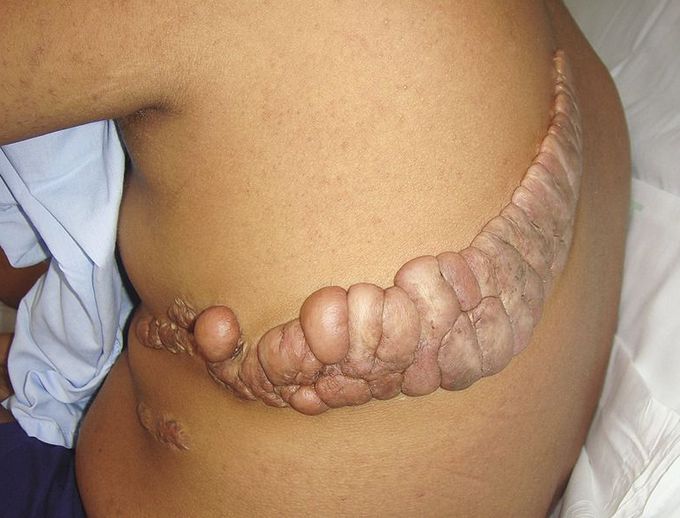


Incisional Keloid
A 24-year-old man underwent thoracic surgery for pulmonary hydatid disease, and 8 weeks later, asymptomatic, tumorlike, cutaneous lesions developed over the incision site. The patient was receiving albendazole as an adjunct therapy. A clinical diagnosis of keloid was made. Keloids typically occur in response to dermal injuries such as surgical wounds, lacerations, burns, or inflammatory skin conditions. Because recurrence is common, surgical removal is generally not recommended; treatments with glucocorticoid injections, laser therapy, or radiotherapy may be tried but are usually associated with a poor response. Given the large size of the lesion in this patient, surgical excision was performed, with an immediate infiltration of glucocorticoids. There was no recurrence 1 month after surgery, and the patient was lost to further follow-up.
Why do Keloid scars happen in the first place? Is it due to genetics?
While we have some knowledge on proteins that are produced at the wrong time or the wrong amount in keloid scars, we do not know what causes keloids in the first place. Some genes are suspected to be involved in keloid formation, but no mutation is known.
Keloid Scars Topic Overview A keloid (say "KEE-loyd") is a scar that grows bigger and wider than the original injury. Keloids most commonly grow on the breastbone, shoulder, upper chest and back, earlobes, and face. Keloids do not become cancer. But they can be bothersome or painful enough that you seek treatment. Keloids often grow back after treatment. It's possible to prevent a keloid from forming if you take steps to protect the skin after it is damaged. What causes a keloid? Keloids can form where the skin is damaged, such as by a surgery cut, a piercing, a burn, chickenpox, or acne. Thick tissue grows up and out from the healing area, making the scar bigger than the original injury. For some people, even a scratch can lead to keloids. Keloids do run in families, and they rarely grow in light-colored skin. Experts think that keloids may be linked to a gene that is linked to dark skin pigment. What are the symptoms? Keloids look like firm, raised, hard scars. They grow larger over time. Their colors vary from slightly pink to very dark. Keloids can rub against your clothes and become irritated, itchy, or painful. When exposed to the sun, they may turn darker than the rest of your skin. The dark color may stay. How is it treated? There is no sure cure for keloids, but treatment sometimes improves how they look and feel. It is common for keloids to grow back after treatment. When trying to treat a keloid, your doctor may need to use more than one type of treatment. Based on a keloid's size and location, and how soon it is treated, your doctor may: Freeze it. This is called cryotherapy. It is best used for small keloids, such as from acne. Cryotherapy can lighten the skin.Inject it with medicine.A corticosteroid is the most commonly used medicine for reducing keloids. It is most likely to work well with cryotherapy or right after surgery.Other medicines may improve keloids. These include verapamil, fluorouracil, bleomycin, and interferon alfa-2b shots. They are not as well studied as corticosteroid shots, but your doctor may recommend trying one. They are most likely to work when used with another treatment.Cut it away. Surgery is sometimes used to remove larger keloids. But removing keloids can lead to more keloids. So it's important to treat the area after surgery. Treatment may include laser or medicine injections.Cover the area with a silicone gel bandage after surgery. You can buy these at most drugstores. Keep the silicone bandage on the skin for 12 to 24 hours a day for 2 to 6 months. Your doctor will tell you when you can stop treatment.Keep pressure on it with a wrap or bandage. Radiation tends to be reserved as a last option for treating keloids. There is a chance that it can cause cancer. Your health insurance may cover some keloid treatments, but not others. Your treatment also may not be covered if the insurance company thinks it's being done only to improve how the scar looks (cosmetic reasons). How can you prevent keloids? If you tend to get keloids, it's best to avoid body piercings, tattoos, or any surgery you do not need. Keloids can grow after these procedures. To prevent keloids after a minor skin injury, start treating it right away. This may help it heal faster and with less scarring. Using the following tips to treat the area may help prevent keloid growth. Cover a new wound with a thin layer of petroleum jelly, such as Vaseline, and a nonstick bandage. Hold the bandage in place with tape so that there is even pressure on the wound. Wash the area with soap and water every day.After a wound is healed over, use a silicone gel bandage. Keep even pressure on the area. This may prevent keloid growth. Keep the bandage on the skin for 12 to 24 hours a day for 2 to 3 months. (It takes 3 months for a keloid to grow).After ear piercing, use pressure earrings. These are also called Zimmer splints.


